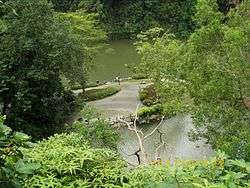Tyersall Park
| Tyersall Park | |
|---|---|
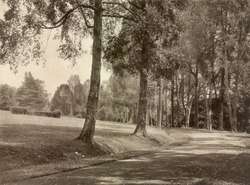 Tyersall, Singapore – c.1910 | |
| Type | Historical landmark |
| Location | Singapore |
| Nearest city | Tanglin, Singapore |
| Coordinates | 1°18′44″N 103°48′40″E / 1.3122°N 103.8111°ECoordinates: 1°18′44″N 103°48′40″E / 1.3122°N 103.8111°E |
| Area | 24.4 hectares (60 acres) (mid-1800s–2009) |
| Founded | mid-1800s |
| Built | mid-1800s |
| Built for |
|
| Original use |
Private residences (approx. mid-1800s–1862) Royal residence (1862–1990) |
| Demolished |
Tyersall House: 1890 Woodneuk House: 1932 Istana Tyersall: 1935 |
| Current use | Restricted property |
| Architect |
Dato Yahya Awaluddin: Istana Tyersall (1892) Denis Santry: Istana Woodneuk (1935) |
| Owner |
|
 Former location in Singapore | |
Part of a series on the |
||||||||||||||||||
|---|---|---|---|---|---|---|---|---|---|---|---|---|---|---|---|---|---|---|
| History of Singapore | ||||||||||||||||||
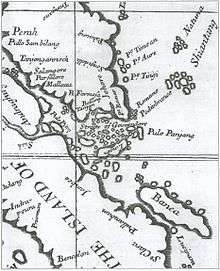 | ||||||||||||||||||
|
Early history (pre-1819)
|
||||||||||||||||||
|
British colonial era (1819–1942)
|
||||||||||||||||||
|
Japanese Occupation (1942–45)
|
||||||||||||||||||
|
Post-war period (1945–62)
|
||||||||||||||||||
|
Internal self-government (1955–63)
|
||||||||||||||||||
|
Merger with Malaysia (1963–65) |
||||||||||||||||||
|
Republic of Singapore (1965–present)
|
||||||||||||||||||
|
| ||||||||||||||||||
Tyersall Park is a historical estate in Singapore, bound by Holland Road and Tyersall Avenue, near the Singapore Botanic Gardens. It was private land belonging to the Malaysian state of Johor from 1862 until its acquisition by the government of Singapore in 1990. The property is restricted from the public and is fenced up along Tyersall Avenue.
The ring road known as Catterick Circle used to run through the estate, and was still shown in maps even after the late Sultan of Johor's former palaces were no longer charted on any modern maps of Singapore. Catterick Circle was officially removed from updated maps of Singapore in the 1990s.
History
Early colonial years
About three to four decades after Singapore was established as a Straits Settlements trading port in 1819, the adjoined estates consisted of Woodneuk and Tyersall at Tanglin were first owned by the English trader Captain John Dill Ross[1] and the lawyer William "Royal Billy" Napier[2] respectively as their private residences.
The first mention of Tyersall in the Singapore newspaper was on 5 November 1860, where the wife of William Paterson, the merchant of Paterson, Simons & Co.[3] gave birth to his son in the Tyersall House as reported by the Singapore Free Press.[4]
The estates would later brought over by Abu Bakar in the late 1850s. He would later moved his residence there from Teluk Belanga upon his reign as the Temenggong in 1862 and made Woodneuk House as his official residence (Istana).[5][6]
In 19 November 1881, the Maharaja of Johor Abu Bakar held the first drag hunt in Singapore with his hounds around Tanglin area, including Woodneuk and Tyersall.[7][8]
It was revealed later in 21 May 1883 that the first telephone line in Singapore had been in operation between Tyersall House and Woodneuk House (or Istana Woodneuk), before the opening of telephonic communication between Singapore and Johor by the Oriental Telephone Company on the following month.[9] In 7 September 1887, the Tyersall Drag Hunt Club had been established there by the Committee as well.[10]
In 1890, Sultan Abu Bakar had Napier's former house demolished to built his palace on its former ground.[11]
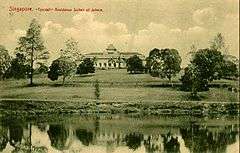
The Istana Tyersall, or Tyersall Palace, was completed and had a grand opening by the Governor of the Straits Settlements Sir Cecil Clementi Smith in 3 December 1892, where the Sultan would held his reception to several historic events and parties. The palace was known to be first building in Singapore to be supplied with electricity.[12][13]
Following his will made on 14 April 1895, Woodneuk was bequeathed to his fourth wife, Sultana Khadijah, and the rest of his premises were being made the State property of the State of Johor. The Sultan departed Singapore in the mail steamer Pekin for Europe in 23 April 1895.[14] Upon his death of pneumonia in South Kensington, London, in 4 June 1895,[15] the Tyersall and its premises were soon handled over to his son upon his reign as the Sultan Ibrahim of Johor in November 1895. The new Sultan however, would preferred to stay at the Woodneuk House.
In 24 April 1899, the Sultan Ibrahim devoted a training ground for polo players from Singapore Polo Club when the racecourse is not available for their training.[16] The training ground which later known as the Tyersall Polo Ground.
In 30 September 1899, Singapore Polo Club hosted the first Horse and Dog Show there,[17][18] followed by the second one in 14 July 1900.[19][20]
Sultan Ibrahim later took over Woodneuk following the death of Sultana Khadijah in 1 February 1904.
In 11 September 1905, a fire broke out at Istana Tyersall at midnight and was put out on the following day by 6.00 am, saw the palace’s ballroom and billard room wrecked, with several furnitures and art collections within them badly burnt.[21][22] The palace was abandoned following that incident.
In 1907, the Sultan gave his permission to the Singapore Hunt Club to use the Tyersall Polo Ground to held gymkhana in 10 February 1907.[23] Later, He gave his permission to the Singapore Automotive Club[24] to held the first motor gymkhana which involved thirty cars in 18 October 1907.[25][26]
In 30 November 1910, the meeting was held at the Straits Chinese Recreation Club's pavilion clubhouse in Hong Lim Green, Singapore, announced that the Sultan was willing to lease the premises and the ground for 21 years at the rental of S$150 per month for the first 7 years, S$250 per month for the next 7 years, and S$350 per month for the last 7 years, all which have been approved by the Committee and members of the Club.[27]
In 7 December 1910, the Tyersall Country Club was formed at the meeting attended by the members of the various clubs of Singapore and chaired by the Governor of the Straits Settlements Sir John Anderson at the abandoned Istana Tyersall,[28]
The Club proposed the plans to become the lessees of Tyersall Palace (Istana Tyersall), to determine the issue of debentures and other matters, which included the dividing of its halls and apartments, the rebuilding of its ballroom and the erection of the new buildings nearby.[29] [30][31][32] However, later in the early 1912, this scheme was reported to have fallen through during the meeting at Tanglin Club.[33]
The last use of Tyersall Polo Ground by Singapore Polo Club as a training ground was 9 January 1915.[34] In 1924, the road known as Garden Road which divided between Tyersall and Singapore Botanic Gardens was renamed to Tyersall Avenue.
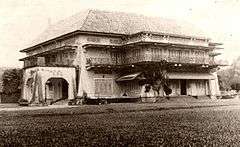
In 1932, a new palace Istana Woodneuk, or Istana Wooden York to the State of Johor, was rebuilt on its former site on another hill not far away and completed in September 1935 as the replacement for the Sultan Ibrahim and his new wife Sultanah Helen.[35][36] The dilapidated Istana Tyersall was reportedly been demolished under the tender issued from the Sultan in 1935.[37]
World War II
In 1939, the Sultan Ibrahim, based on Johor at that time, had allowed part of Tyersall to be used by the Indian Army to be stationed and converted as a military camp area with many vehicles in a mechanisation effort in preparation for World War II.[38] The estate, or grounds, was referred as Tyersall Park, Tyersall Camp, or Tyersall Park Camp in the news and to the military stationed there.[39][40] In 8 August 1939, the Second Battalion of Argyll and Sutherland Highlanders under Lieutenant Colonel Ian MacAlister Stewart arrived in Singapore from India[41] and later moved to Tyersall Park in December 1939 as part of 12th Indian Infantry Brigade.
The 12th Indian Infantry Brigade headquarters, and the Indian Military Hospital, which consisting of the cluster of thatched huts built by the contractor A. G. Dobb and Co.[42] for the 4/19th Hyderabad Regiment, were set up at Tyersall Park.[43][44]
In 7 August 1941, the Maharaja of Patiala Yadavindra Singh, during his two-day visit in Singapore to inspect its defences, visited the Indian Military Hospital at Tyersall Park on the Thursday afternoon.[45]
In 29 January 1942, the 210 Royal Marines, who were the survivors of HMS Prince of Wales and HMS Repulse, moved to Tyersall Park to join with the 250 Argylls, and later in 3 February 1942, they were amalgamated into a composite battalion known as the Plymouth Argylls (in reference to the Argylls affiliation to the Plymouth Argyle Football Club and that all the Marines were from the Plymouth Division).
Japanese invasion of Singapore
In 9 February 1942 during the Battle of Singapore, the Plymouth Argylls left late in the morning towards the Tengah airfield.
The Istana Woodneuk, under the name of "Tyersall Palace",[46] was temporary served as the 2/30th Battalion AIF headquarters under Major General Gordon Bennett.
In 11 February 1942, the 2nd Battalion of Gordon Highlanders moved to Tyersall Park from the bombed Birdwood Camp at Changi, and departed for Bukit Timah to battle with the invading Japanese Imperial Army.
After the blast of Japanese mortar attack which indicated that the nearby junction of Holland Road and Ulu Pandan Road were held by the Japanese Imperial Army, Major General Bennet withdrawn his headquarters from Woodneuk to Tanglin Barracks.
The Indian Military Hospital, despite having Red Crosses painted on the roofs, was destroyed by fire caused by the incendiary bombs deliberately dropped by the Japanese fighter planes, and it was later estimated that about 700 medics and patients had reportedly burned to death in the area.[47]
Later on the following day in 12 February 1942 in the afternoon, the surviving Plymouth Argylls arrived back at Tyersall Park, only to find themselves involved in a major rescue operation there.
Japanese occupation of Singapore
Following the Japanese Occupation of Singapore, in 17 February 1942, Piper Charles Stuart was ordered by the Japanese to march the surviving Plymouth Argylls out of Tyersall Park to Changi.
Tyersall Park would later served as one of the seven Indian Army personnel interned POW camps in Singapore under Lieutenant Colonel Gurhux Singh of Jind State Forces, who was under the supervision of the Japanese Imperial Army until 1945.[48]
Post-war era
After Singapore was liberated in 1945, the Supreme Allied Command South East Asia (SACSEA) headquarters was set up at the Tyersall Park. 58 members of the Women's Voluntary Service were also stationed there.[49] The Istana Woodneuk was briefly occupied by General Sir Miles Dempsey and later by Commander-in-Chief Sir Montagu Stopford in 1946 until November when SACSEA was disbanded.
In 16 January 1947, the palace was occupied by Governor-General of Malaya Malcolm MacDonald and his wife.[50][51] By 1948, the palace was returned to the Sultan for his official residence in Singapore.
In 1954, the Tyersall Park was leased out for military use, in 1959, the estate returned to the Sultan of Johor, later on, the Johor State Council approved $5,000 for the maintenance and upkeep of Tyersall Park in 17 April 1959.[52]
Recent developments
In December 1990, the Government of Singapore had acquired the part of the former Tyersall Park from the State of Johor.[53] On 1 June 2004, the sum of S$25 million was awarded as compensation for the compulsory acquisition of Tyersall. On 9 June 2004, the Collector obtained an order of court to pay the said compensation into court due to the dispute with the State of Johor as to the title to receive the compensation.[54]
In 2009, the Government of Singapore had acquired 9.8 ha part of 24.4 ha of the former Tyersall Park estate from the State of Johor as part for the "Tyersall" extension of Singapore Botanic Gardens,[55] which involved the repositioning of the existing Tyersall Avenue, the demolition of the two main gates along Tyersall Avenue which once leads to the former Tyersall Park and Istana Woodneuk, the restructuring of visitor access to the National Orchid Garden and Ginger Garden, the creation of fresh water swamp forest and the extension of the National Orchid Garden nursery.
In 31 March 2017, the Singapore Botanic Gardens' new extension was officially opened as the Learning Forest by Lee Hsien Loong, the 3rd Prime Minister of Singapore.[56]
In popular culture
Tyersall Park was first mentioned in Kevin Kwan's first novel of the Crazy Rich trilogy, Crazy Rich Asians, as a 64-acre estate belonged to Shang Su Yi, Nick Young's grandmother. The estate would later become a major plot point in Kwan's third and final novel of the trilogy, Rich People Problems.[57]
In the production of the film Crazy Rich Asians based on the novel of the same name, Carcosa Seri Negara, the former luxury hotel which consisted of the two colonial mansions at Perdana Botanical Gardens, Kuala Lumpur, Malaysia, were used to depict the interior and exterior of Tyersall Park. A lake was later digitally added to the estate grounds in post-production. In the Condé Nast Traveler interview with film director Jon M. Chu, Chu said: “There were certain aspects to Tyersall Park, where Nick’s grandmother lives, that you couldn’t find in Singapore. That’s what makes the fictional Tyersall Park, this sort of Central Park within the tight squeeze of Singapore, such an amazing location in the book, because those properties just don’t exist anymore. So we had to go to Malaysia to film that part.”[58][59]
See also
References
- ↑ "John Dill Ross, merchant". Retrieved 2018-08-14.
- ↑ "THE HEART OF THE LION CITY". Retrieved 2018-08-14.
- ↑ Singapore, National Library Board,. "Paterson, Simons & Co. | Infopedia". eresources.nlb.gov.sg. Retrieved 2018-08-15.
- ↑ "BIRTH". Retrieved 2018-08-15.
- ↑ "Singapore - Sheet 5/35 (Orchard, Tanglin, Holland)". nas.gov.sg. Retrieved 2017-12-27.
- ↑ "Singapore. Instrumental Plot - Tanglin and Holland". www.nas.gov.sg. Retrieved 19 December 2017.
- ↑ "Tyersall Drag Hunt". Retrieved 2018-08-15.
- ↑ "The Maharajah's Hounds". Retrieved 2018-08-15.
- ↑ "Untitled". Retrieved 2018-08-15.
- ↑ "Tyersall Drag Hunt Club". Retrieved 2018-08-15.
- ↑ "The New Singapore Residence of H. H. the Sultan of Johore". Retrieved 2018-08-15.
- ↑ "MONDAY 5th DECEMBER. The Sultan of Johore's Singapore Residence". Retrieved 2018-04-01.
- ↑ "The New Singapore Residence of H. H. the Sultan of Johore". Retrieved 2018-04-01.
- ↑ "DEPARTURE OF THE SULTAN OF JOHORE". Retrieved 2018-08-15.
- ↑ "The Sultan of Johore". Retrieved 2018-08-15.
- ↑ "POLO". Retrieved 2018-08-15.
- ↑ "THE TYERSALL SHOW". Retrieved 2018-08-15.
- ↑ "HORSE AND DOG SHOW". Retrieved 2018-08-15.
- ↑ "HORSE AND DOG SHOW AT TYERSALL". Retrieved 2018-08-15.
- ↑ "HORSE AND DOG SHOW". Retrieved 2018-08-15.
- ↑ "A PALACE ABLAZE". Retrieved 2018-04-01.
- ↑ "SERIOUS FIRE AT TYERSALL". Retrieved 2018-04-01.
- ↑ "HUNT CLUB GYMKHANA". Retrieved 2018-08-15.
- ↑ "MOTOR GYMKHANA". Retrieved 2018-08-15.
- ↑ "Automobile Meet at Tyersall". Retrieved 2018-08-20.
- ↑ "FIRST MOTOR MEETING". Retrieved 2018-08-20.
- ↑ "PROPOSED COUNTRY CLUB". Retrieved 2018-04-01.
- ↑ "DAILY TIME TABLE". Retrieved 2018-04-01.
- ↑ "Tyersall Country Club". Retrieved 2018-04-01.
- ↑ "THE TYERSALL CLUB". Retrieved 2018-04-01.
- ↑ "A Country Club". Retrieved 2018-04-01.
- ↑ "Newspaper Article -". Retrieved 2018-04-01.
- ↑ "TANGLIN CLUB". Retrieved 2018-04-01.
- ↑ "FIXTURES". Retrieved 2018-08-15.
- ↑ "THE HOME BEAUTIFUL BUILT FOR SULTAN OF JOHORE". Retrieved 2018-04-01.
- ↑ "HER HIGHNESS THE SULTANAH HELEN". Retrieved 2018-08-07.
- ↑ "Memories of ©16 Singapore". Retrieved 2018-08-07.
- ↑ "Singapore Indian Troops Live In Sultan's Park". nlb.gov.sg. Retrieved 27 January 2018.
- ↑ "Soldier Found Dead Outside Canteen". Retrieved 2018-08-15.
- ↑ "IN DEFENCE OF SINGAPORE". Retrieved 2018-08-16.
- ↑ ""THE THIN RED LINE" COMES TO SERVE IN MALAYA". Retrieved 2018-08-20.
- ↑ "PREPARED TO SHARE". Retrieved 2018-08-16.
- ↑ Brig Jasbir, Singh (2010). Escape from Singapore. India: Lancer Publisher. p. 16. ISBN 1935501208.
- ↑ "Indian Troops Keep Good Health In Singapore". nlb.gov.sg. Retrieved 27 January 2018.
- ↑ "MAHARAJAH'S LOCAL TOUR". Retrieved 2018-08-16.
- ↑ "269 - April/June, 1983 - 2/30 Battalion Photo Gallery". www.230battalion.org.au. Retrieved 2018-08-16.
- ↑ Taylor, Ron. "Chronology of Singapore". www.britain-at-war.org.uk. Retrieved 27 January 2018.
- ↑ Brig Jasbir, Singh (2010). Escape from Singapore. India: Lancer Publisher. p. 50. ISBN 1935501208.
- ↑ "ARMY IN 200 BUILDINGS". Retrieved 2018-08-16.
- ↑ "MR. MACDONALD TO LIVE IN SINGAPORE". Retrieved 2018-08-16.
- ↑ "GOV.-GEN. ARRIVE TO-DAY". nlb.gov.sg. Retrieved 27 January 2018.
- ↑ "$5,000 to upkeep a park". Retrieved 2018-08-16.
- ↑ "NewspaperSG - BUSINESS TIMES, 1 December 1990". Retrieved 2018-08-16.
- ↑ Neelima. "State of Johor and Another v Tunku Alam Shah ibni Tunku Abdul Rahman and Others[2005] 4 SLR 380; [2005] SGHC 156". www.singaporelaw.sg. Retrieved 2018-08-16.
- ↑ "Botanic Gardens' Tyersall site dates back to 1854". www.asiaone.com. Retrieved 2018-08-03.
- ↑ Kimberley, Wang (30 Mar 2017). "PM Lee Hsien Loong officially opens Singapore Botanic Gardens Learning Forest" (PDF).
- ↑ Post, The Jakarta. "Tyersall Park drama absolutely not inspired by Oxley Road: Kevin Kwan". The Jakarta Post. Retrieved 2018-08-21.
- ↑ Carey, Meredith. "Where Was 'Crazy Rich Asians' Filmed?". Condé Nast Traveler. Retrieved 2018-08-21.
- ↑ "The 'Crazy Rich Asians' guide to Singapore". CNN Travel. 2018-08-13. Retrieved 2018-08-21.
